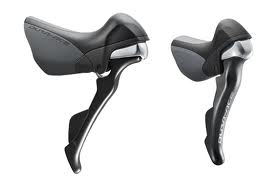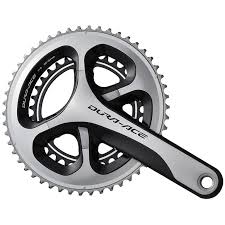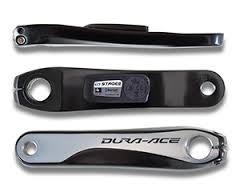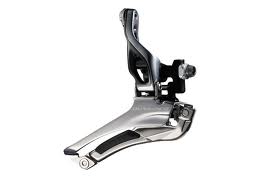Shimano Dura Ace 9000 Group – A Longer Term Review
By Jim Weaver, Service Manager, Fit Werx, VT
Last winter, after attending a seminar put on by Shimano, I wrote an article about the then forthcoming Shimano Dura Ace 9000 “11 speed” component group. We have had the opportunity to build a number of bikes with this new system and I thought that I would take a few moments to update my previous article with my longer term impressions of this new gruppo.
 First things first – Dura Ace 9000 works fantastic and that has almost nothing to do with the fact that it offers an 11 speed cassette. The shift levers have a lighter, more positive feel than the previous generation Dura Ace 7900 and a shorter lever stroke and this directly addresses my complaint about the shifting of the 7900 series being more vague than the Dura Ace 7800 that preceded it (mainly due to the shift cables being moved under the bar tape). Through improvements in the internal shifter mechanisms, ergonomics and a new super low friction cable set, the front and rear shifting is noticeably more precise and quicker – exactly what you would expect of Dura Ace. The new STI lever housing has a more ergonomic shape that certainly fits my hands better while also offering 10mm of reach adjustment to accommodate a wide range of hand sizes.
First things first – Dura Ace 9000 works fantastic and that has almost nothing to do with the fact that it offers an 11 speed cassette. The shift levers have a lighter, more positive feel than the previous generation Dura Ace 7900 and a shorter lever stroke and this directly addresses my complaint about the shifting of the 7900 series being more vague than the Dura Ace 7800 that preceded it (mainly due to the shift cables being moved under the bar tape). Through improvements in the internal shifter mechanisms, ergonomics and a new super low friction cable set, the front and rear shifting is noticeably more precise and quicker – exactly what you would expect of Dura Ace. The new STI lever housing has a more ergonomic shape that certainly fits my hands better while also offering 10mm of reach adjustment to accommodate a wide range of hand sizes.
While it may not be the sexiest part of the group, the new cables are actually big news when it comes to Dura Ace 9000. Shimano’s new Dura Ace derailleur cables and housings have a new polymer (very similar to Teflon) coating that improves the movement of the cables inside the housings. The new cables and housing even come with their own specifically designed cable ends that protect the polymer coating from abrasion. These cables work, offering noticeable improvement over standard stainless steel cables. The new Dura Ace 9000 will work with traditional stainless steel cables and conventional housings, albeit with degradation in performance. Unfortunately, replacement cables are expensive at $29.00 per cable, but they will retrofit to most any previous generation of Dura Ace, Ultegra, or even 105 if you are looking to help those groups really reach their potential.
Somehow, Shimano made some of the very best brakes on the market even better; the new Dura Ace 9000 brakes are even stronger and offer better feel than Dura Ace 7900. As with the shifting, Shimano recommends using their specific cables and housings, including housing end caps. In fact, there have been cases where we have found that the simple addition of the recommend housing end caps improves the feel of the brakes – so we recommend using the whole system together if you want it to work to its potential. The brake cables have the same polymer coating as the derailleur, offering the same advantages. The cost, you ask? $31.00 per cable. As with the shifting, conventional cables and housings will work, albeit not as well, and previous generation product can be upgraded to the new cables.
 One of the most visually noticeable items on the new Dura Ace 9000 series group is the 4-arm crankset, which is a sculptural work of engineered art. It not only looks great, but it is one of the stiffest and best shifting cranks we have ever worked with here at Fit Werx. Front shifting has traditionally been one of Shimano’s strongest points, due to the stiffness of their derailleurs and chainrings, and the new chainrings continue that tradition. Front shifting, like the rear, is quick and precise. There is absolutely no crank flex when you stomp on the pedals. The asymmetric design of the crank’s “spider” definitely seems to impart greater stiffness and better power transfer through the high power portion of the pedal stroke. The Dura Ace 9000 crank is also currently one of the only cranks on the market where the crankarms are the same for compact or standard gearing. This means that you can just switch chainrings if you want to change from compact to standard gearing (or vice-versa).
One of the most visually noticeable items on the new Dura Ace 9000 series group is the 4-arm crankset, which is a sculptural work of engineered art. It not only looks great, but it is one of the stiffest and best shifting cranks we have ever worked with here at Fit Werx. Front shifting has traditionally been one of Shimano’s strongest points, due to the stiffness of their derailleurs and chainrings, and the new chainrings continue that tradition. Front shifting, like the rear, is quick and precise. There is absolutely no crank flex when you stomp on the pedals. The asymmetric design of the crank’s “spider” definitely seems to impart greater stiffness and better power transfer through the high power portion of the pedal stroke. The Dura Ace 9000 crank is also currently one of the only cranks on the market where the crankarms are the same for compact or standard gearing. This means that you can just switch chainrings if you want to change from compact to standard gearing (or vice-versa).
I’m sometimes asked why Shimano makes their cranks out of aluminum when almost all of their competitors use carbon on their higher end options. Well, a few years ago Shimano actually made a carbon fiber Dura Ace crank in small numbers and it was arguably an inferior product to the less expensive alloy version and they did not produce it for very long. Shimano says that they always select the material they use based on what is best for the application and for what production technology is superior for that part. So, they use carbon when it offers benefits over alloy and they use alloy when it holds benefits over carbon. No one in the bike industry has the forging capabilities of Shimano; they demonstrate year-after-year that they can forge alloy into a finished product than either equals or exceeds what anyone else is offering in carbon. The Dura Ace 9000 crankset is very much proof po sitive of this approach. As an added benefit, for the power training crowd, a Stages Power Meter (likely the least expensive and lightest quality power meter on the market, see picture) is completely compatible, which is not the case for any carbon crank.
sitive of this approach. As an added benefit, for the power training crowd, a Stages Power Meter (likely the least expensive and lightest quality power meter on the market, see picture) is completely compatible, which is not the case for any carbon crank.
While the crank has been one of Shimano’s very best components for years, it has often had to spin in one of their weakest products – their bottom brackets. Don’t get me wrong, Shimano bottom brackets are not physically weak. In fact, they have always been practically bomb-proof. The problem is drag. When compared to after-market bottom bracket options, a significant amount of effort was needed to actually get the crankset to spin the Shimano bearings. Well, Shimano apparently has heard the complaints and has taken steps to improve the performance of this vital component. The result is a bottom bracket that spins easier than before. While it is still not close to being as free-spinning as some of the lowest resistance after-market bottom brackets from companies like Hawk Racing or Ceramic Speed, it is an improvement over the 7900 bottom bracket. The new Dura Ace 9000 bottom bracket is lighter as well due to a new bearing and cage design. So far, we have not seen any issues with durability of the unit compared to previous generations.
Criticisms? Setting up 11 speed front derailleurs can be challenging as they have very little leeway and it is easy to get some rub in some combinations, even with proper set-up, on some of the bikes with the shortest chainstays. The bottom bracket, while improved, could still see improvements in rolling resistance. I wish the cables cost less (at least they work really well…). You have to use Shimano chainrings (why you would want to use something else on this crank I don’t know…). All pretty nit-picky.
 All in all, the redesigned Dura Ace 9000 component group is impressive and a step forward from 7900 in every regard. Shimano has done a great job addressing the complaints people had with 7900 (mainly that it did not shift as smoothly as 7800…) while upping the ante on what a mechanical group can offer on things like front shifting performance. As I have said before, the seemingly intense competition between Shimano, SRAM, and Campagnolo benefits all of us, with each new generation of components from each company being significantly better than the last. Components ten years ago were quite good and it was often easy to wonder if they could improve much. Like taking a ride on Campagnolo’s Record or Super Record or the latest SRAM RED group, if you ride the new Dura Ace 9000 you will realize just how far things have come.
All in all, the redesigned Dura Ace 9000 component group is impressive and a step forward from 7900 in every regard. Shimano has done a great job addressing the complaints people had with 7900 (mainly that it did not shift as smoothly as 7800…) while upping the ante on what a mechanical group can offer on things like front shifting performance. As I have said before, the seemingly intense competition between Shimano, SRAM, and Campagnolo benefits all of us, with each new generation of components from each company being significantly better than the last. Components ten years ago were quite good and it was often easy to wonder if they could improve much. Like taking a ride on Campagnolo’s Record or Super Record or the latest SRAM RED group, if you ride the new Dura Ace 9000 you will realize just how far things have come.
For those not ready to go to Dura Ace, the new “11 speed” Ultegra 6800 components are starting to ship as well and Ultegra 6800 carries many of the Dura Ace based design features minus some of the slippery coatings, bearings and ultralight materials and forging that make Dura Ace what it is. In our experience, outside of weight, Ultegra gives up little initial performance to Dura Ace and the true differences tend to show up more in the long term where Dura Ace retains its initial feel and tautness better. Either way, this next generation of Shimano components is the best from the Japanese company yet and that bodes well for everyone.

